Supracor LASIK – Presbyopia
A laser eye surgery solution for Presbyopia (the need for reading glasses)
From late thirties onwards, people increasingly find difficulty reading. Laser eye surgery, now over 30 years old and well-established, works extremely well for shortsight, farsight and astigmatism. For the last 10 years the option of a “multifocal’ laser treatment has been available and continually refined. Supracor LASIK is an option to improve the range of focus for those struggling to read.
Why do I have difficulty reading ?
The crystalline lens inside the eye is able to change shape enabling objects up close to be placed into focus. At birth, the crystalline lens is like jelly and changes shape very easily. With age the lens gets bigger with added layers, much like a tree-trunk, and as a result becomes harder and more resistant to change. When this fine focus reduces, the point of focus gets further away, and people typically hold objects much far than usual. Those who are short-sighted find they are able to see better up close if they take their glasses off. This condition is called Presbyopia. Those who are farsighted tend to be affected earlier, often in their late thirties.
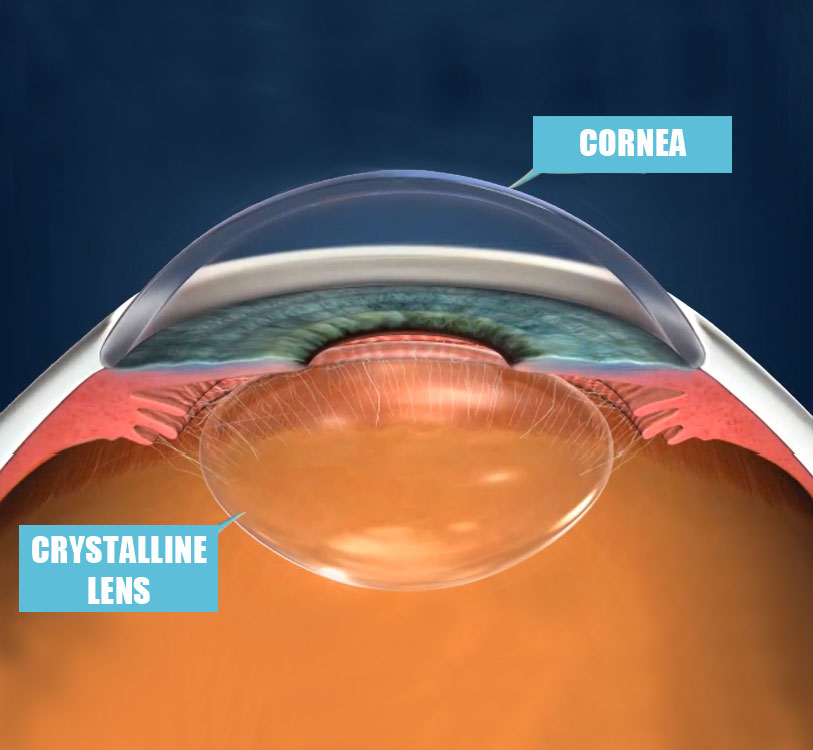
“I was fed up of wearing glasses and various vision aids. Supracor has given me freedom and my experience at Centre for Sight was fantastic, friendly and I felt at ease at every step.“
L.M.
Centre for Sight Patient
What are the options to correct presbyopia?
There are a number of options available, and the type of procedure chosen depends on several factors including age, the health of the eye as well as visual needs.
Laser Lens Replacement Surgery with multifocal / trifocal lenses
This is an excellent option that provides good vision at distance, intermediate and near in both eyes equivalently. It is suitable for those over 50 years old. Although many competitors will perform this in over 40-year-olds, we at Centre for Sight will not, except in exceptional circumstances, perform this procedure in patients under the age of 50. Those who are farsighted and over 50 are considered as are short-sighted patients over 55. The reason for this is based on peer-reviewed literature to be an unacceptably high rate of retinal detachment in those undergoing this type of procedure at a younger age. For those who are suitable based on age and ocular health, of all lenses available, a trifocal lens (introduced by Centre for Sight to the UK in 2011) is the preferred option.
Supracor LASIK
This is an option for those between the ages of 40 and 50. This procedure is a LASIK laser vision correction option performed in the non-dominant eye of the patient. It is a multifocal treatment on the cornea providing a high power to enable reading in the centre of the cornea and correction of distance vision in the area just outside the centre. The dominant eye, if required, undergoes LASIK with full distance correction using an aspheric or wavefront aspheric to provide excellent distance vision. Once fully recovered and adapted, with both eyes open, patients have a good range of focus including distance, intermediate and near and less dependent on glasses.
Initially the difference between the two eyes can be noticeable and over time the brain adapts to the new optical system extracting the best vision possible. Initially the Supracor LASIK blended vision eye is a bit short-sighted and distance vision is a little blurred, but over time this improves as the brain picks up the information that is present. With good distance vision in the dominant eye, good intermediate vision in both eyes and better near vision in the Supracor eye, the two eyes “blend” to provide the full range of focus. While this works extremely well in most patients, some, particularly those who are older and towards or within their 50s, do report requiring a thin pair of readers for prolonged and intense near activity. They are overall able to function well except having to depend on reading glasses all the time. The goal of supracor blended vision is to reduce dependency on glasses.
Patients who are already using “monovision” with their contact lenses are suitable for Supracor LASIK. In those who have not tried this option, suitability for the procedure is determined at consultation by a contact lens trial making the non-dominant eye a little short-sighted. The key endpoint in the trial is finding out if the patient is able to cope with a slight blur at distance in their non-dominant eye.
Corneal Inlays
Plastic corneal inlays have been used in the past, but all have been withdrawn commercially. Centre for Sight we pride ourselves in never using this option. Our view has been the cornea does not like anything foreign embedded within it except corneal tissue or corneal collagen. An inlay that really does work well is the allotex transform corneal graft inlay which is a microscopic layer of corneal tissue implanted under a corneal flap. Centre for Sight has been involved in a study of this option and outcomes have been excellent with the cornea behaving very much like one that has had Supracor LASIK blended vision. This option will hopefully be commercially available in the near future.
Monovision
What to expect after Supracor Lasik?
Distance vision in the treated non-dominant eye may be poor.
each eye of the same patient may behave differently. The near vision correction is placed in the very centre of the cornea and the cornea becomes slightly steeper in the centre than usual. This results in a “Multifocal” cornea with different zones for distance and near. Near vision from the first day is usually excellent and remains the same.
Distance vision is highly variable from being fairly good to being quite poor soon after surgery. Distance vision is better with both eyes open. The first week is often the most difficult for distance vision and driving can be difficult. The majority of patients eventually cope well once they start to adapt and distance vision continues to improve gradually.
At 3 months vision is a lot better, however still might not be perfect at distance. By 6 months both distance and near vision is good with both eyes open.
Why is distance vision initially poor?
There are a few reasons for this phenomenon.
- The cornea is made to be multifocal and the eyes optical system changes. The brain is used to analysing optical information received from the centre of the cornea but now has to adjust to a multifocal cornea. The centre now has a very small zone for near correction and an outer zone for distance. Cortical (the location in the brain) adaptation is the process where the patient gradually gets used to deciphering information from the altered optical system and becomes able to analyse distance visual information.
- A slight myopic correction is intended as the eyes do regress a little over time. This early myopia results in blurry distance vision.
- Those who have been farsighted (hyperopic) have always had a tendency to “accommodate” or use the muscles inside the eye to change the shape of the lens in the eye to focus. The trigger for this mechanism is ‘blur’ – when the brain receives a slightly blurry image, its compensatory mechanism to correct the blur is for the eye muscles to go into action. This is the opposite of what is required and makes the eye more myopic making distance vision more blurry – a vicious cycle! This does eventually stop and vision at distance improves. Patients often find their vision is better at distance, late in the day when tired, or first thing in the morning on awakening when the eye is relaxed.
- Temporary dry eye is not uncommon after LASIK surgery and in the case of Supracor the central slightly steep area is prone to drying more, with tears evaporating in this area faster. As this area is in the visual axis, blurry vision for both distance and near is a possibility. This is temporary and will in time, resolve. If this does occur, frequent use of lubricants is necessary and will improve vision. At your Centre for Sight preoperative evaluation, you will have dry eye testing and if dry eye is evident, treatment would not be recommended. In some cases of slight tear underproduction, temporary Punctual Plugs are inserted to prevent tears from draining away. By about 8 to 12 weeks the majority of dry eye problems resolve.
Temporary halos at night
This phenomenon can sometimes occur although reported rarely. The cornea is multifocal and visual information is split between distance and near. At night, when the pupil is wide open, halos may initially occur. With cortical adaptation, the brain “tunes out” the poor information and the halos from the treated eye disappear.
More on how Supracor LASIK works
This is a LASIK/ IntraLASIK procedure where a very precisely sized thin flap is created using the Intralase femtosecond laser. An excimer laser (Bausch + Lomb Technolas) is then used to sculpt the cornea, lasering microscopic amounts and fashioning at customised profile. The profile has a small area in the centre of the cornea which is a little steeper and provides the near vision focus as well as an increase in asphericity which improves visual quality.
Following are the profiles of the treatments both in hyperopic and myopic presbyopia –
Hyperopic Supracor treatment – laser profile
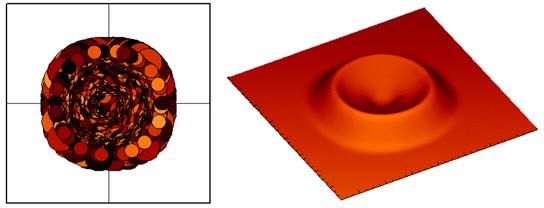
Myopic Supracor treatment – laser profile
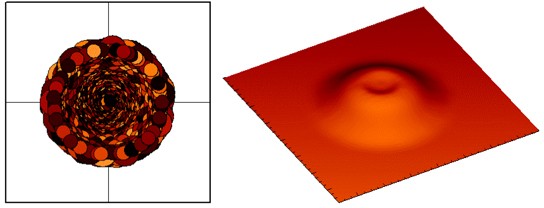
Supracor results
These are results from the CE marking European Multicentric Study (courtesy Technolas) for Hyperopia (Farsightedness). Notice distance vision improves with time, however near vision is excellent right away and remains stable.
Distance vision
(96% see distance sc 0.8 or better (6M)
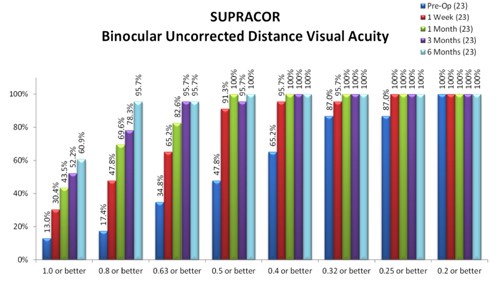
Near vision
(91% see near sc 0.8 or better)
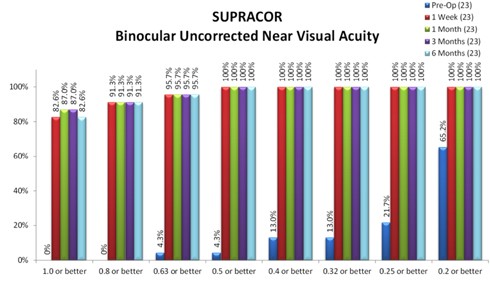
Common Questions
The dominant eye should have excellent vision and with both eyes open vision should meet the DVLA standard for driving. If you feel that driving is not safe, then you are urged to get a pair of temporary spectacles to help, but only use them when distance vision is critical. Using the glasses all the time will delay the process of cortical adaptation.
Yes. Although unusual, this is possible and there is a software option for this. The typical patient will have good distance vision but near may not be as good. An enhancement will be considered at 3 months at the earliest.
A dramatic difference is noted immediately in terms of near vision and all patients are able to read a newspaper immediately after the procedure. As discussed above, to begin with the treatment does make patients a little short-sighted (-0.50D), in other words vision is slightly blurry at distance and this improves over the following weeks. Distance vision continues to improve month by month and 6/7.5 (20/25) vision is obtained in 74% at 3 months 96% at 6 months. (Multicentric CE marking study).
Suitability for treatment requires a thorough consultation with specific investigations including the degree of Presbyopia (requirement for reading glasses). Treatment is available for those who are farsighted, short-sighted and astigmatism. Find out if you are suitable for Supracor – contact Centre for Sight to book a consultation.
YES – patients who have previously had Laser eye surgery have had successful outcomes following Supracor LASIK. Understandably those who have experienced the benefit and visual freedom from previous laser eye surgery are really motivated to stay out of glasses including readers. Supracor Lasik is an excellent option for this group of patients.
Care following this type of procedure is identical to Lasik / Intralasik the details of which are found here
Author Information
Authored by Sheraz Daya MD FACP FACS FRCS(Ed) FRCOphth, Consultant Ophthalmic Surgeon & Medical Director, Jan 2022.
Next review due Jan 2025.
I understand that all my data, clinical and otherwise will be protected under GDPR. I understand my data may used for the purposes of quality improvement and advancement of eye care such as audit. This is a component of good clinical governance and measures will be taken to ensure my data is not identifiable.
